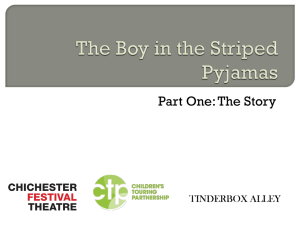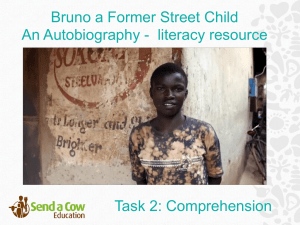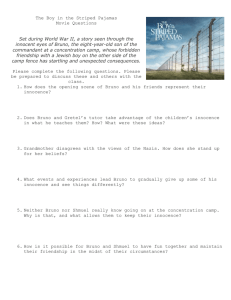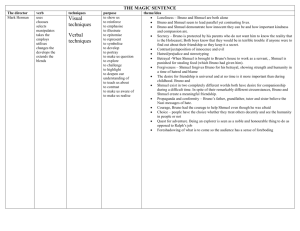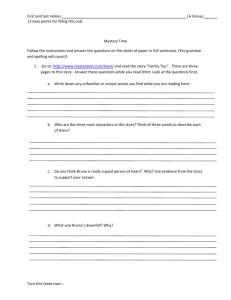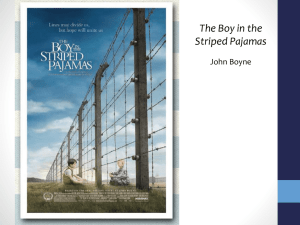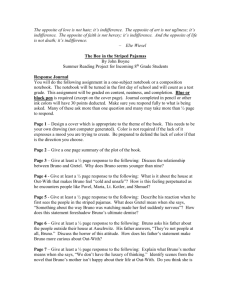A discussion guide for youth group facilitators, educators and
advertisement
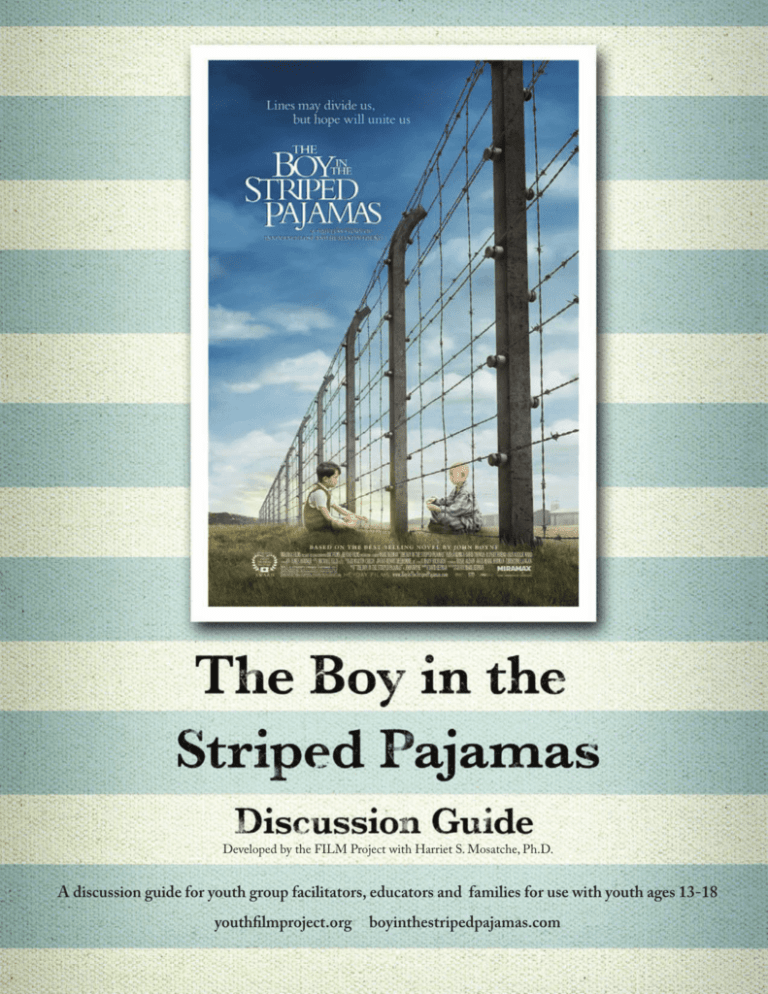
Developed by the FILM Project with Harriet S. Mosatche, Ph.D. A discussion guide for youth group facilitators, educators and families for use with youth ages 13-18 youthfilmproject.org boyinthestripedpajamas.com Ta bl e of C on t e n t s Introduction.................................................................................................................................3 Steps for Youth to Take . ...............................................................................................................4 Discussion Questions....................................................................................................................5 Exploring an Innocent Perspective....................................................................................6 The Essence of Friendship.................................................................................................7 Acts of Humanity.............................................................................................................8 Understanding Obedience and Conformity........................................................................9 Exploring Prejudice and Discrimination........................................................................10 Taking the Lead.........................................................................................................................11 Activity Ideas.................................................................................................................11 Social Justice Service Projects..........................................................................................12 Advocacy to End Genocide..............................................................................................13 Appendix...................................................................................................................................14 Definitions....................................................................................................................14 Resources.......................................................................................................................15 - 2 - I n t roduc t ion The Boy in the Striped Pajamas depicts a fictional friendship set during World War II. Bruno, the eight-year-old son of a newly-promoted Nazi officer, moves with his family from a comfortable life in Berlin to a lonely existence in the countryside. An adventurous boy with nothing to do, Bruno ignores his mother’s instructions not to explore the back garden and takes off for a “farm” he has seen from his bedroom window. As he approaches a barbed wire fence, Bruno sees Shmuel, the boy in the striped pajamas, on the other side, and an unlikely and life-changing friendship develops. Based on a fiction novel, the movie explores important real-life themes, such as experiences that gradually end an innocent perspective, the essence of friendship, acts of humanity even under horrific circumstances, the uses and abuses of obedience and conformity, and the development of prejudice and its destructive consequences. This guide provides discussion prompts and activity ideas that will allow youth to not only understand historical facts and issues, but to explore their application in today’s world. This program guide is best used after viewing the Miramax movie and reading the book, The Boy in the Striped Pajamas by John Boyne. As a facilitator, your role is to create a supportive environment that encourages the youth in your group to express their feelings and beliefs, and to engage in constructive dialogue with their peers. The Appendix (pg. 15) contains definitions and other resources that offer help in answering questions that may arise in discussion. Because of the sensitive nature of this movie and its themes, be prepared for the possibility of strong emotions that the questions and activities might elicit, particularly if they have family members who were affected by the Holocaust during World War II or genocide in other countries, such as Rwanda or Iraq. Encourage young people to act as advocates and take action to fight prejudice and discrimination in their communities, country, and around the globe. Help them see that by understanding and acting on the lessons learned in this story, they can make a positive difference in the world. The FILM Project is made possible through the partnership of Heartland Truly Moving Pictures and the National Collaboration for Youth. Heartland is a non-profit organization that seeks to recognize and honor filmmakers whose work explores the human journey. The National Collaboration for Youth is a non-profit organization providing a unified voice for its coalition of more than 50 national, non-profit, youth development organizations, and concentrates on improving the conditions of youth in the United States and enabling youth to realize their full capabilities. - 3 - S t e ps f or You t h t o Ta k e w i t h Th e B oy i n t h e S t r ipe d Paja m a s D isc ussion G u i de Step 1) See the Film and Read the Book The Movie: The Boy in the Striped Pajamas, a Miramax film, opens in theaters on November 7, 2008 and will be available on DVD at a later date. The Book: The Boy in the Striped Pajamas by John Boyne (David Fickling Books/Random House, 2006) is available in hardcover and paperback. Many other books, both fiction and non-fiction, have been written about the Holocaust. See the Appendix (pg. 15) for suggestions. Step 2) Participate Take part in discussions and activities that address themes in the story from the movie and book: • Exploring an innocent perspective • The essence of friendship • Acts of humanity • Understanding obedience and conformity • Exploring prejudice and discrimination Step 3) Take the Lead to Help Others Using the story of Bruno and Shmuel as inspiration, young people are urged to learn to take on responsibility by designing and conducting a service project that addresses issues of prejudice, stereotyping, and discrimination in their communities. Youth are also encouraged to advocate for an end to hatred and genocide in the world. Use the free, downloadable service-learning supplement to assist in the planning and managing of service projects. Please visit youthfilmproject.org/resources.htm to download the supplement, developed in partnership with Youth Service America. To gain more information on the movie and the book visit boyinthestripedpajamas.com. - 4 - D isc ussion Q u e st ions Use the questions in this section to spark meaningful discussions across five different themes. It is not necessary to cover every single question. If a particular topic or question especially resonates with your group, spend more time discussing it. And you might find that discussion about one theme naturally leads to questions related to a different theme. Allow the young people in your group to guide the nature and pace of the discussion. What is most important is using the discussion to help meet the following objectives. O bj e c t i v e s For You t h • Engage in discussions that encourage thinking and learning about: • The essence of true friendship • The courage to engage in humane actions • The uses and abuses of obedience and conformity • The development and consequences of prejudice and discrimination • Extend learning through activities and exercises that address the discussion themes. • Design and implement a service project that promotes an end to prejudice and discrimination. • Advocate for an end to hatred and genocide in the world. - 5 - E x pl or i ng a n I n no ce n t P e r spe c t i v e The story includes an interesting contrast of an innocent child’s perspective in a setting with circumstances far from innocent. This section explores the meaning and value of an innocent perspective and how it enables this story to unfold. • What do “innocent” and “naïve” mean when used to describe children? • How does the opening scene of Bruno and his friends represent their innocence? • Can adults be naïve? In what ways can they be naïve? What adults in the movie seemed naïve? • Can you give an example of a time when you were a young child and saw the world from a more innocent perspective? What are some examples of that? What experiences helped you see the world differently than what you initially thought? • Does Bruno and Gretel’s tutor take advantage of the children’s innocence in what he teaches them? How? What were these ideas? • Although the story takes place during a tragic time in history, there are moments of humor in the story. One occurs when Bruno tells Pavel that he could not be a very good doctor because he had to “practice” it. How does this example and others in the movie demonstrate Bruno’s naïveté? Can you give other examples from the movie of misinterpretation as a result of innocence? What about in your own life? • Although Bruno and his family have moved to a desolate place, Bruno continues to display his strong sense of adventure and creativity. What are some examples of this in the movie? Can you give an example from your own life when your sense of adventure and imagination allowed you to escape from a sad or painful situation? • What events and experiences lead Bruno to gradually give up some of his innocence and see things differently? • Why was it so hard for him to believe that his father could be involved in hurtful acts? • Neither Bruno nor Shmuel really know going on at the concentration camp. Why is that, and what allows them to keep their innocence? • Why do you think the movie and book ended the way they did? - 6 - Th e E sse nce of Fr i e n dsh i p Friendship is a central theme of this story, and this section explores the reasons, depths and meaning of friendship explored in this story. • Why do you think Bruno and Shmuel become friends and stay friends? • How do the friendships that Bruno has in Berlin at the beginning of the movie compare with his friendship with Shmuel? • Does the friendship between Bruno and Shmuel evolve in the story? How? • Why doesn’t Bruno try to protect his friend when Shmuel is attacked by Lieutenant Kotler? • Have you ever done something to a friend that made you feel bad or ashamed? How does shame and remorse figure into the friendship between Bruno and Shmuel? How does Bruno show his remorse? • Why does Shmuel forgive Bruno? How? • How is it possible for Bruno and Shmuel to have fun together and maintain their friendship in the midst of their circumstances? • How does Bruno justify continuing his friendship with Shmuel despite what his father, sister, and tutor have said about Jews? • The barbed wire fence is a physical separation between Bruno and Shmuel. What other types of separation does the fence represent in this story? • How do Bruno and Shmuel demonstrate the essence of friendship despite their many differences? What are their differences? • How can people use the power of friendship to cross boundaries of race, religion, and culture? - 7 - Ac t s of Hu m a n i t y The author of the book and the creators of the movie crafted the story as a fable. A fable is story with a moral, one that teaches a lesson about humanity. The section explores the depths of humanity that are possible in the most trying of circumstances. • Think about fables you know and the lessons associated with those fables. What are the lessons to be learned from this fable, and the moral of this story? • Contrast Pavel’s treatment of Bruno when the boy fell from the tire swing with the way Pavel is treated by Bruno’s family. • Mother saying “thank you” to Pavel for treating Bruno is an important turning point for her. What has changed for the mother at this point? • At times, Father is shown as a loving parent and husband. How is that possible given his role as a Nazi officer giving orders to treat people inhumanely? • Bruno tried to help Shmuel find his father despite being frightened and wanting to go home. Why? • What does Bruno say and do to show his growing understanding of the inhumanity going on around him, including to his friend Shmuel? • Have you ever been in a situation where a person was mistreated? What actions did you take? How did you feel after acting or not acting? • Bruno secretly took food from his house to give to Shmuel because it was one concrete way he could help his friend. Have you ever done something to help people who didn’t have enough food? What can people do today to help people who are starving around the world? • Do you know anyone, or have you read about Jews or other persecuted people, who survived the Holocaust or other grave circumstances due to the courageous actions of others? Share those stories. • What do you think causes people to treat others in such horrific ways as was done during the Holocaust? Are there people being treated like this anywhere in the world today? What is or can be done to stop it? - 8 - Un de r sta n di ng O be di e nce a n d C on f or m i t y This section explores the value of thinking and acting for the benefit of others, and how that can sometimes mean going along with everyone else, and other times not. • What is peer pressure? Have you been in situations in which you felt compelled to go along with a group? Describe those situations and why you acted as you did. • Grandmother disagrees with the views of the Nazis. How does she stand up for her beliefs? • What is propaganda? How is propaganda used to “sell” people on a viewpoint? • The short film shown by Father in the movie to his soldiers is considered propaganda. What was the purpose of this propaganda? • When Mother learns that Jews are being exterminated at the camp, she questions her husband. “How can you?” she asks. He responds: “Because I’m a soldier.” Contrast these two perspectives. • Father tries to use guilt to get Mother to change her opposition to his involvement in the exterminations. Does it work? Why or why not? • Gretel believes the viewpoints of Lieutenant Kotler, the tutor Liszt, and Father about Jews. Although Bruno is younger than his sister, he questions their viewpoints. Why? • How is obedience constructive and how can it be destructive? Give examples from the story of each. • What are ways of advancing peace and harmony in life through constructive disobedience? • List examples in history where civil disobedience has been constructive. - 9 - E x pl or i ng P r ej u dice a n d D iscr i m i nat ion The story takes place during a traumatic period in the world’s history. This section explores the damage to humanity that prejudice and discrimination have, and how and why it’s important to fight against them. • Prejudice is an attitude while discrimination is a behavior. Explore these differences? • Have you ever been discriminated against? When have you witnessed discrimination against other people or discriminated against someone else? • What is a stereotype? Why do people stereotype groups that are different from them? How does the movie depict Nazis stereotyping Jews? • A scapegoat is blamed for things they are not responsible for. During the Holocaust, Jews became scapegoats, blamed for all the troubles in Germany. Why were they made scapegoats? • Gretel becomes prejudiced against Jews. Who influenced her? How does she show her prejudiced views? • What is Mother’s reaction when she sees Gretel’s room decorated with Nazi posters? • What happens to cause Mother to question her own prejudice against Jews? • When Bruno first finds out that Shmuel is Jewish, he says: “You’re a Jew. You can’t be. I think I should go now.” Why does Bruno react that way at first? • When you hear someone make a biased comment about a group of people, what do you usually do? How hard is it to stand up to prejudice and discrimination? Why? • In the story, who fights against prejudice and discrimination? Give examples of people in history who fought against prejudice and discrimination. • What conflicts around the world today are the result of prejudice? What are its effects on innocent people, including children? • In your opinion, what does the end of story symbolize? Why? - 10 - Ta k i ng t h e L e a d This section offers activity and leadership ideas for young people around the themes in the movie, The Boy in the Striped Pajamas. Activity Ideas • Learn more about the Holocaust by reading one of the books, visiting one of the websites, or seeing one of the films listed in the Appendix. • With a small group, role play one or more of the themes from the movie: obedience, discrimination, acts of humanity, stereotyping, etc. • Write a short story or a poem about an unlikely friendship. • Do research to learn about genocide occurring in the world today. • Create a poster about the damage caused by prejudice. • Interview a survivor of the Holocaust or a child or grandchild who knows the personal stories of a friend or relative. • Construct a piece of art—a sculpture, a painting, a drawing, or a comic strip—that represents the effect of friendship and humanity vs. prejudice and discrimination. • Go to the United States Holocaust Memorial Museum website (www.ushmm.org) to find a calendar of traveling exhibitions related to the Holocaust. Visit an exhibition at a location near where you live. - 11 - - 12 - - 13 - A ppe n di x The Boy in the Striped Pajamas was set during a horrific era in world history. This section contains definitions that are relevant in a discussion of that time period. You will also find a list of resources—books, websites, and films—that will allow young people to develop more in-depth knowledge about the Holocaust. Definitions Concentration Camps: prisons set up by German Nazis where Jews and other people considered “undesirable” were starved, tortured, killed, or left to die of disease. Discrimination: treating people differently simply because they belong to a certain race, religion, gender, or other group. Gas Chambers: buildings constructed to allow poisonous gas to be used for the extermination of Jews and others during the Holocaust. Genocide: the intentional killing of people who belong to a particular race, religion, culture, or other group. Holocaust: refers to the mass killing by German Nazis of six million Jews in Europe during World War II. Prejudice: biased attitude toward individuals based solely on their race, religion, nationality, or other characteristic. Propaganda: information purposely distorted to sway people’s thinking in a particular direction Shoah: the Hebrew word for “tragedy” that is used to refer to the Holocaust - 14 - Resources Books: Frank, Anne. The Diary of a Young Girl. New York: Doubleday/Bantam, 1995. Kahn, Leora and Rachel Hager, eds., When They Came to Take My Father. New York: Arcade Publications, 1996. Friedman, Ina R. The Other Victims: First-Person Stories of Non-Jews Persecuted by the Nazis. Boston, MA: Houghton Mifflin, 1990. Laird, Christa. Shadow of the Wall. New York: Greenwillow, 1990. Lowry, Lois, Number the Stars. Boston: Houghton Mifflin, 1989. Reiss, Johanna. The Upstairs Room. New York: HarperCollins, 1990. Rittner, Carol, and Sondra Myers. The Courage to Care: Rescuers of the Jews During the Holocaust. New York, New York University Press, 1986. Toll, Nelly S. Behind the Secret Window: A Memoir of a Hidden Childhood. New York: Dial Books, 1993. Wiesel, Elie, Night. New York: Bantam, 1982. Yolen, Jane. The Devil’s Arithmetic. New York, Puffin, 1990. Websites: Anti-Defamation League: adl.org Genocide Watch: genocidewatch.org The Holocaust Martyrs’ and Heroes’ Remembrance Authority: yadvashem.org Save Darfur. savedarfur.org United States Holocaust Memorial Museum: ushmm.org Films: Anne Frank—The Whole Story. Walt Disney, 2001. Made for television. Holocaust. Republic Pictures, 1998. Made for televsion mini-series. - 15 - Into the Arms of Strangers—Stories of the Kindertransport. Warner Home Video, 2000. Rate PG. Life is Beautiful. Miramax, 1998. Rated PG-13. Miracle at Midnight. Walt Disney, 1998. Made for television. The Pianist. Universal, 2002. Rated R. Schindler’s List. Universal, 1993. Rated R. Sophie’s Choice. Lions Gate, 1982. Rated R. - 16 -
